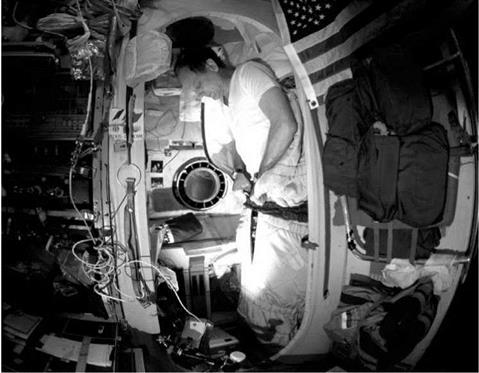. SOYUZ TM21
Flight Crew
DEZHUROV, Vladimir Nikolayevich, 32, Russian Air Force, commander STREKALOV, Gennady Mikhailovich, 54, civilian, flight engineer, 5th mission Previous missions: Soyuz T3 (1980); Soyuz T8 (1983); Soyuz T10-1 pad abort (1983); Soyuz T11 (1984); Soyuz TM10 (1990)
THAGARD, Norman Earl, 51, civilian, NASA cosmonaut researcher,
5th mission
Previous missions: STS-7 (1983); STS 51-B (1985); STS-30 (1989); STS-42 (1992)
Flight Log
Veteran Shuttle astronaut Norman Thagard became the first American to fly into space on a foreign launch vehicle and spacecraft as crew member of Soyuz TM21. He was also a member of the 18th resident crew on Mir and would participate in a programme of 28 experiments, most of which were focused on biomedical research. When the joint programme was planned, it was expected that most of the American research equipment would be delivered with the Spektr research module, but this was seriously delayed (and in fact did not dock with Mir until half-way through Thagard’s residence), so most of Thagard’s equipment had to be delivered by Progress re-supply craft. Scheduling problems affected the planning of this mission due to delays in preparing Spektr for launch, which in turn affected the scheduling of STS-71, the first Shuttle-Mir docking mission. Most of the working time of the two Russian cosmonauts was consumed by maintenance and repair tasks, mostly on the environmental and thermal regulation systems of the station. Reports indicated that at least 40 per cent of their working time was taken up with such tasks, as the station was now beginning to show signs of its age.
In preparation for receiving the new module at the station, Progress M23 was undocked from the front port of Mir. Then the two Russian cosmonauts had to complete a series of EVAs to retract the solar arrays on Kristall and reposition them on Kvant to facilitate the rearrangement of the module using the Ljappa arm. The first
|
US astronaut Norm Thagard in his sleep restraint aboard Mir, the first of seven NASA astronauts to live and work aboard the Russian station as resident crew members |
three EVAs were in support of retracting the solar arrays on Kristall. This module had been located initially where Spektr was due to be docked at the —Y port (negative Y – these locations refer to the facing of the docking ports on the station along the X, Y and Z axes) so it had to be moved. Kristall was moved on 26 May from the — Y port to the —X port, and then to the —Z port on 29 May after the cosmonauts had performed an internal EVA (IVA) to relocate the docking systems. Spektr docked at the —X port on 1 June and the next day was moved to the —Y port, again after an IVA to relocate docking equipment. Kristall was rotated to the —X port on 10 June and Atlantis docked with it on 29 June during the STS-71 mission. After the departure of the Shuttle, Kristall was relocated from the —X port back to the —Z port on 17 July.
The five EVAs, totalling 18 hours 43 minutes were conducted on 12 May (6 hours 14 minutes), 17 May (6 hours 42 minutes), 22 May (5 hours 14 minutes), 29 May (21 minutes IVA) and 2 June (22 minutes IVA). On 5 June, the two arrays of Spektr were deployed but one of them failed to fully open and an unscheduled EVA was planned for 16 June to manually unfurl the array in order to provide sufficient power during the docked phase of the Atlantis STS-71 mission. However, Strekalov argued that the EVA was unnecessary and very hazardous as they had not trained for it.
He refused to conduct the EVA despite pressure from Dezhurov. The electrical power was eventually estimated to be sufficient for the docking, but the cosmonauts were fined 15 per cent of their fee for the mission for failing to conduct their sixth EVA.
Thagard had to contend with several frustrating problems during his stay on the station. A freezer broke down, causing many of the samples he had taken to be lost. He also felt isolated, as communication with Earth was far less frequent on Mir than on the Shuttle, but kept himself informed of what was happening on Earth thanks to contact with a ham radio operator in California. Thagard also lost weight and became bored, although the arrival of the Spektr module helped keep him busy. It quickly became apparent to the Americans that flying with the Russians on a long-duration Mir mission would be very different to flying short missions on the Shuttle. Thagard’s flight became the longest by an American astronaut to date, finally surpassing the 84-day record held by the Skylab 4 crew since 1974. Just like the pioneering Skylab long-duration missions, Thagard’s 115 days in space proved to be another valuable, if difficult, learning curve for NASA. It was also clear, however, that there would be many more hurdles to overcome during the Phase 1 programme.
Milestones
178th manned space flight
80th Russian manned space flight
18th Mir resident crew
73rd manned Soyuz mission
20th manned Soyuz TM mission
26th Russian and 57th flight with EVA operations
1st US astronaut launched on Russian spacecraft
1st US astronaut crew member on a main Russian crew
1st US resident astronaut on Mir
Thagard celebrated his 52nd birthday in space (3 Jul)











